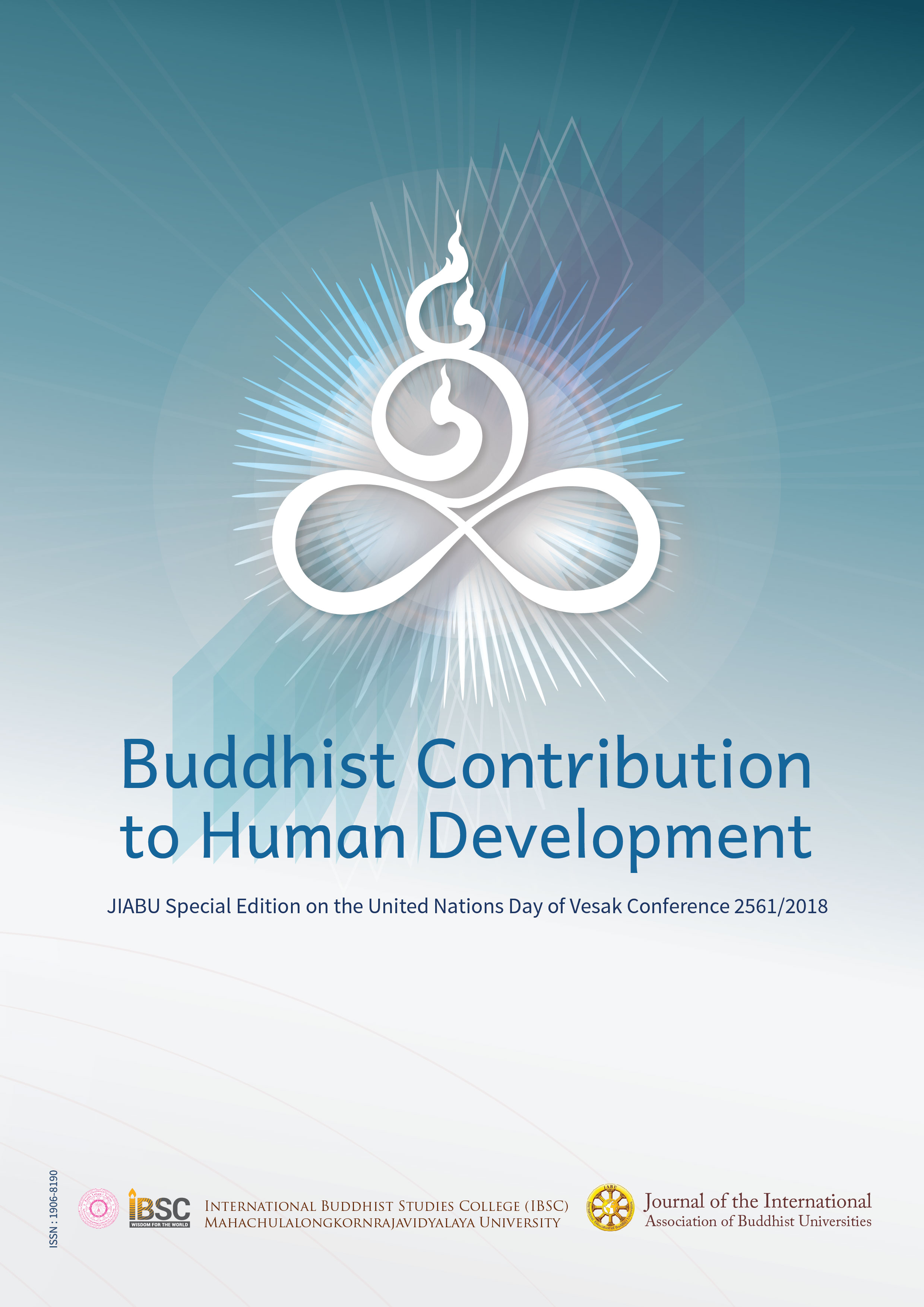An analytical study of Mindfulness from Buddhism to Psychology
Main Article Content
Abstract
Mindfulness has been introduced by Dr. Jon Kabat-Zinn into the medical assistance
service and later it has been developed into several famous psychological therapies. Although
Dr. Jon Kabat-Zinn has an original intention to combine Dharma with science and make the
Dharma better benefits to people’s lives, but has the development of psychotherapy changed
the power of Dharma as compared to its applications in Buddhism? In order to respond to
this question, this article is designed as an analytical study to find out the developing path
of mindfulness from Buddhism to psychology.
In order to achieve the objective, it was divided into three parts to do the analytical
study. Firstly, it discussed the background of Mindfulness-Based Stress Reduction (MBSR) to
know the basic ideas of Buddhist mindfulness that has been taken into the medical application.
Secondly, it discussed the practical application of Mindfulness-Based Cognitive Therapy
(MBCT) to know how basic ideas is applied in psychology. Thirdly, it made an analytical
comparison of two kinds of mindfulness in Buddhism and MBCT. Based on these three parts,
it has found out the development path of mindfulness from Buddhism to psychology.
By achieving the objective, it has shown that Mindfulness-based therapies are created
in social and cultural background, it has become an interdisciplinary research object and
needs the coordinated development of the related disciplines to well understand each other
for achieving greater benefits; and mindfulness functions to realize the universal dharma
which could integrate subjective and objective dualism to form a harmonious lifestyle.
Article Details
Views and opinions expressed in the articles published by The Journal of the International Association of Buddhist Universities (JIABU), are of responsibility by such authors but not the editors and do not necessarily reflect those of the editors.
References
Grossman, P., Niemann, L., Schmidt, S., & Walach, H. (2004). Mindfulness-based stress reduction and health benefits: A meta-analysis. Journal of psychosomatic research, 57(1), 35-43.
Haydicky, J., Shecter, C., Wiener, J., & Ducharme, J. M. (2015). Evaluation of MBCT for adolescents with ADHD and their parents: Impact on individual and family functioning. Journal of Child and Family Studies, 24(1), 76-94.
Kabat-Zinn, J. (2003). Mindfulness-based interventions in context: past, present, and future. Clinical psychology: Science and practice, 10(2), 144-156.
Kabat-Zinn, J. (2011). Some reflections on the origins of MBSR, skillful means, and the trouble with maps. Contemporary Buddhism, 12(01), 281-306.
Kabat-Zinn, J., & Hanh, T. N. (1991). Full catastrophe living: Using the wisdom of your body and mind to face stress, pain, and illness. New York: Bantam Dell.
Kabat-Zinn, J., tr. by Wen Zong-kun.(2013). Some reflections on the origins of MBSR, skillful means, and the trouble with maps. Fuyan Buddhist Studies. (8): 187-214.(乔•卡巴金著, 温宗堃译,“关于 MBSR 的起源, 善巧方便与地图问题的一些思考”,福严佛学研究,2013年第8期第187-214页。)
King, A. P., Erickson, T. M., Giardino, N. D., Favorite, T., Rauch, S. A., Robinson, E., Kulkarni M., & Liberzon, I. (2013). A pilot study of group mindfulness-based cognitive therapy (MBCT) for combat veterans with posttraumatic stress disorder (PTSD). Depression and anxiety, 30(7), 638-645.
Li, Si-long. (2007). On the Division of Time and the Transformation of Buddhist Study in Europe and America. Studies in World Religions,(3):65 – 7.(李四龙,“论欧美佛教研究的分期与转型”,世界宗教研究, 2007年第3期第65-72页。)
Segal Z V, Williams J M G, Teasdale J D. tr. by Xinhua Liu. (2008). Mindfulness-Based Cognitive Therapy for Depression. Beijing: World Book Inc. (Chinese version: 抑郁症的内观认知疗法.刘兴华译.北京:世界图书出版公司, 2008.)
Suzuki, D. T. (1991). An introduction to zen buddhism. New York: Grove Press.
Suzuki, D. T. (2010). The training of the Zen Buddhist monk. New York: Cosimo, Inc.
T.2, No. 125, EĀ.24, p.680,b24, c10. (瞿曇僧伽提婆译,《大正藏》,《增壹阿含經》,(善聚品第三十二•九) ,第2册,第24卷,第125经。)
T.2, No. 125, EĀ.5, p.569, c01. (瞿昙僧伽提婆译,《大正藏》,《增壹阿含经》,(壹入道品第十二•四),第2册, 第5卷,第125经。)
Taisho Tripitaka Publication Association. (1988). Taishō Tripiṭaka. Tokyo:Daizo shuppansha. (大正新修大藏经刊行会编,《大正藏》东京:大藏出版株式会社, Popular Edition in 1988.)
Teasdale, J. D. (1999). Emotional processing, three modes of mind and the prevention of relapse in depression. Behaviour research and therapy, 37, S53-S77.
Teasdale, J. D., Segal, Z. V., Williams, J. M. G., Ridgeway, V. A., Soulsby, J. M., & Lau, M. A. (2000). Prevention of relapse/recurrence in major depression by mindfulness-based cognitive therapy. Journal of consulting and clinical psychology, 68(4), 615-623.
Wen Jinyu. (1997). Chan and the western world. Forum on Chinese Culture. (4): 78-81(温金玉,“禅与西方世界”,中华文化论坛,1997年第4期第78-81页。)
Williams J M G, Teasdale J D, Segal Z V,tr. by Jieqing Tan. (2009). The mindful way through depression: Freeing yourself from chronic unhappiness. Beijing: China Renmin University Press. (Chinese version: 改善情绪的正念疗法.谭洁清译。北京:中国人民大学出版社,2008。)
Williams, J. M. G., & Kabat-Zinn, J. (2011). Mindfulness: diverse perspectives on its meaning, origins, and multiple applications at the intersection of science and dharma. Contemporary Buddhism, 12(01), 1-18.


